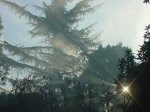
Here's the description from the Nasa Image Gallery:
Bow Shock Near a Young Star
Revealing the stunning and intricate treasures that reside within the nearby, intense star-forming region known as the Great Nebula in Orion, the Hubble Space Telescope focused on one such jewel--a bow shock around the very young star, LL Ori.
Named for the crescent-shaped wave made by a ship as it moves through water, a bow shock can be created in space when two streams of gas collide. LL Ori emits a vigorous solar wind, a stream of charged particles moving rapidly outward from the star. Our own sun has a less energetic version of this wind that is responsible for auroral displays on the Earth.
The material in the fast wind from LL Ori collides with slow-moving gas evaporating away from the center of the Orion Nebula, which is located to the lower right in this Heritage image. The surface where the two winds collide is the crescent-shaped bow shock seen in the image.
Unlike a water wave made by a ship, this interstellar bow shock is a three-dimensional structure. The filamentary emission has a very distinct boundary on the side facing away from LL Ori, but is diffuse on the side closest to the star, a characteristic common to many bow shocks.
This image was taken in February 1995 as part of the Hubble Orion Nebula mosaic.
Image Credit: NASA and The Hubble Heritage Team (STScI/AURA)





No comments:
Post a Comment